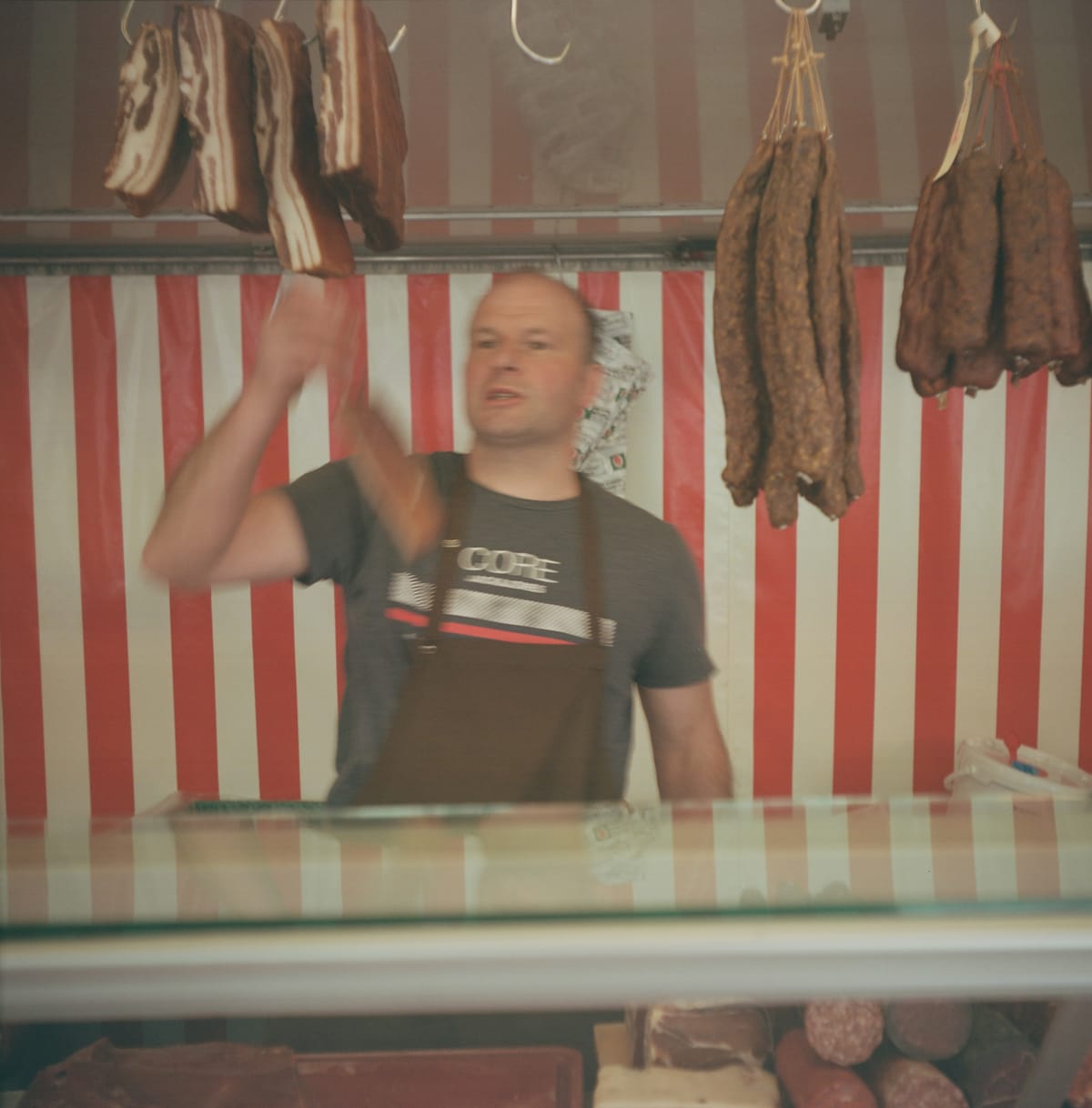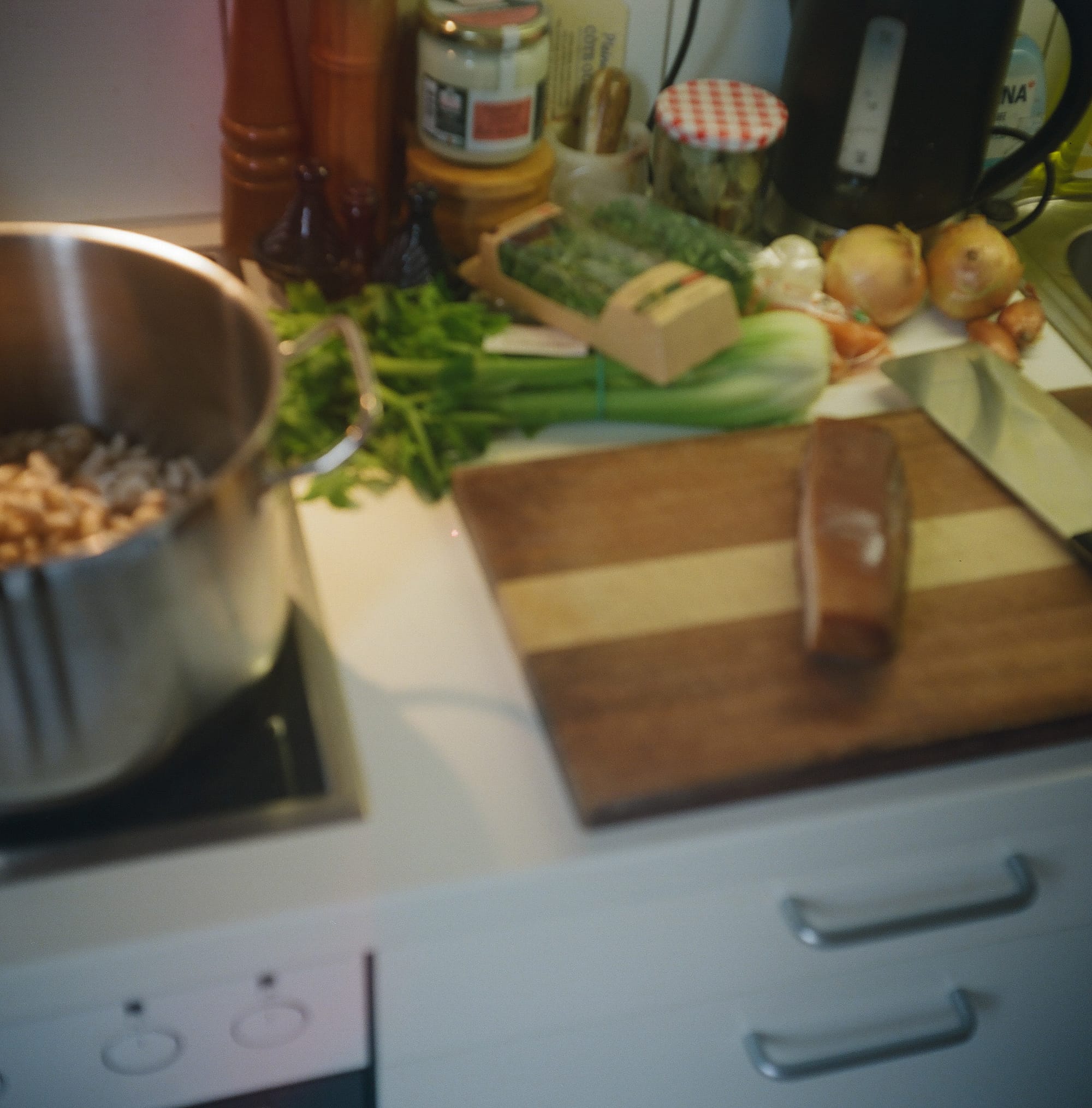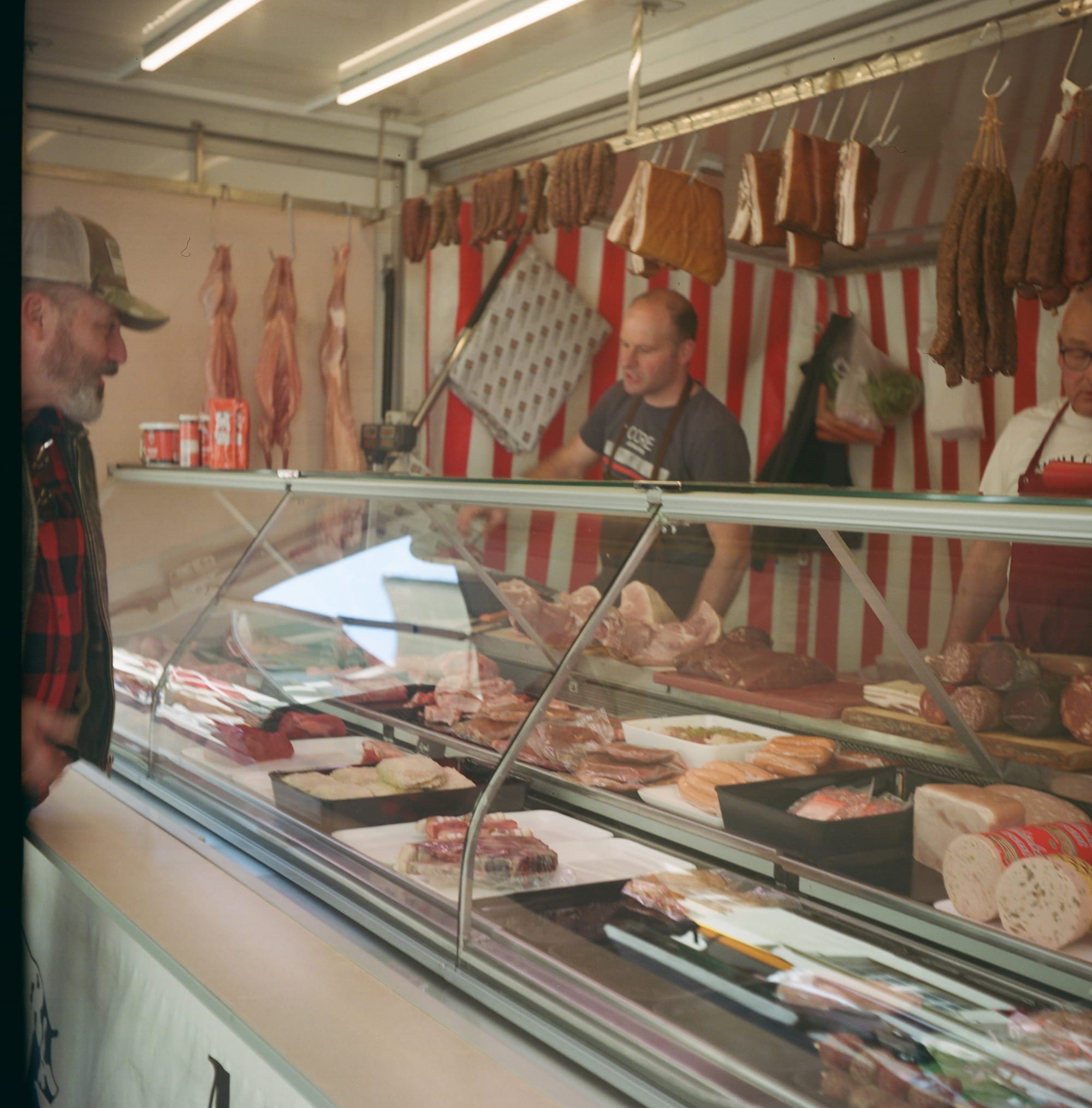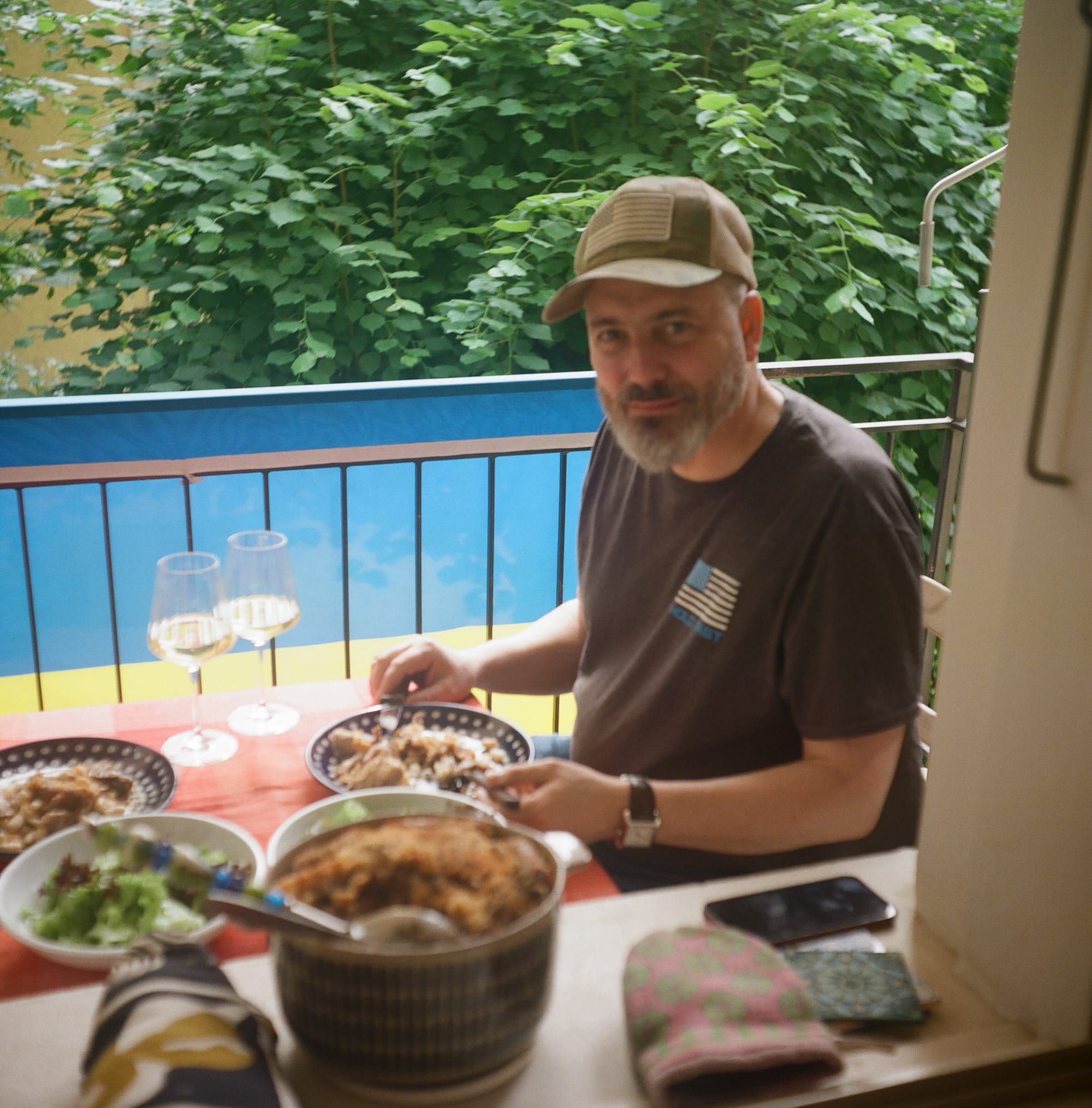What to eat FRANCE 🇫🇷 Cassoulet
France’s national dish, cassoulet... has deep roots in the history of the European continent, religious wars, and of course the peasants’ need to stretch a few bad cuts a good mile... it is a way of enforcing a distinction or rivalry between the people we might otherwise refer to as neighbors.

Published June 15, 2024 · by Amanda Rivkin Häsler
I am not French and I am about to write about French cooking. My greatest claim to anything resembling Parisian elite status is my father spent his earliest years on Rue Jacob in the heart of the left bank on what is now a preposterously elite street.
But alas, his mother did not send him out with samples to inspect whether the calfskin chartreuse couch was appropriately soft but rather for basic provisions as these were the lean years of the immediate postwar period. Luxury boutiques likely meant you could have your cake and eat it, too, literally, not in a Marie Antoinette sense. Children, after all, were less likely to experience the sting of biting racism and prejudice than adults for reasons that a little boy can still make a bitter adult's heart melt and children learn languages faster than anyone. Damn kids!
By way of such a disclaimer, know that France’s national dish, cassoulet, or one of many claiming the title, has deep roots in the history of the European continent, religious wars, and of course the peasants’ need to stretch a few bad cuts a good mile. All the while, like all things European, it is a way of enforcing a distinction or rivalry between the people we might otherwise refer to as neighbors.
The myth of the cassoulet dates back to the Hundred Years’ War of the late Middle Ages or early modern period of the fourteenth and fifteenth centuries between the kingdoms of England and France. Plagues interrupted the internecine fratricide in western Christendom with spurts of disease-borne death as a break from battlefield-born death. Epidemiology and technology along with modern defense technologies have allowed us to condense the misery in time and space before it can become truly horrible.
But returning to our otherworldly narrative that bears only passing resemblance to contemporary woes, people needed to stretch bad cuts of meat due to budgetary restrictions with much cheaper ingredients. And they needed to feel full in order to make it through yet another gruelling day of life. So not terribly unlike now, but with the magnitude of poverty, disease and warfare magnified manifold. We have it pretty good, we just do not know it.
In any case, the creation myth of cassoulet goes something as follows: under siege from England, the people of the French village of Castelnaudary pooled their provisions to cook a dish so hearty they were fortified enough that they could lead a counter-putsch against the English and send them back across the Channel, where they belonged, to England! Rumor has it Edward the British Prince even ransacked Castelnaudary en route to Bourdeaux! That bastard!
Pity that tale seems to be some bullshit and no such battle occurred. If the people of Castelnaudary were left to fend for themselves, it was more likely due to poor resource allocation by their local feudal lords. And rumors probably fed the myth that gave life to a Hundred Years’ War story that lives on today.
The real story may be even more sordid: Muslims! Mohamed of Baghdad was known for a spiced mutton stew with legumes. And he may have even influenced Medieval French chefs with his creative culinary prowess. Terrible, isn’t it? Like a spicy war on terror, only delicious and terrible only if you are so profoundly into la France profunde that you cannot see how the Mediterranean has influenced culinary tastes and habits – then and now.
Even more profoundly un-French than that may be the reality that the famous tarbais bean that is associated with the Frenchest of French cassoulet may not even have arrived until the 16th century via the new world, the Americas. But it is as popular of an import as Jerry Lewis and the worst B-movies ever.
Before that, the broad bean would have been standard in Europe. These days however, in the era of the nation-state and EU “protected geographical” products, it has special status as French. C’est la vie!
So in this new and inclusive Europe of the last few centuries where slaughters don’t really occur after 1945 (if we do not look too closely at Bosnia or Ukraine or even Belarus) and mass tourism is actually the biggest bane of our existence along with two month holidays where the family can really grate, Castelnaudary can do a victory lap. Sure two other villages, Carcassone and Toulouse also claim to have invented cassoulet but the creation myth of Castelnaudary stands as the GOAT (or the greatest of all time for those who are not extremely online) and Mohamed of Baghdad who?
So what is cassoulet? One hundred years ago, chef Prosper Montagué described it as “god himself.” More recently, chef André Daguin told National Geographic last year, “Cassoulet is not really a recipe, it’s a way to argue among neighboring villages,” specifically in Gascony. Now, sorry to dismiss Mohamed of Baghdad’s influence, but is there truly anything more European than that?
To return to Montagué and the spirituality of cassoulet, along with the extraordinary Christianity that has overtaken the myths around the dish, if Castelnaudary cassoulet is “God the father,” then Carcasonne is “God the son,” and Toulouse is doing its duty as “the Holy Spirit”. Then is Mohamed of Baghdad Mary? Responsible for the Immaculate Conception?
So as if this is not all French enough, because it is, it gets even more so. In 1970, La Grande confrérie du cassoulet de Castelnaudary or the Grand Brotherhood of the Cassoulet of Castelnaudary was established to increase the prestige of cassoulet and defend the traditions and quality of cassoulet, which are under siege from… barbarian cassoulet non-purists? That Edward guy who was pushed back across the Channel? Wrong answers only!

As a dish itself, it’s not the purest. You use pork and duck or goose or mutton or some kind of cheap cuts of meat and stretch it with beans, add some bread crumbs and voilà, taking your time you can produce cassoulet. If you are into meat and beans, the variations are limitless, the spices, flavor and French touches however are not. My American approach to French culinary disputes remains irrefutable if not utterly so.
Four years before the confrérie or cassoulet fraternity of Castelnaudary was founded, the ever eminent États Généraux de la Gastronomie Française at least offered an opinion in the form of a ratio. Thirty percent or just under one third of the contents of cassoulet must be meat. That may seem abstract or unhelpful but it is certainly not devoid of pretension.
Joël Robuchon, the chef who has received more Michelin stars than anyone, would point out that the meat element of cassoulet is the most “contentious”. In Castelnaudary, surprise, no pork is used! Mohamed of Baghdad’s special touch? There they prefer confit goose or duck. In Carcassone, pork chops are preferable. Whereas in Toulouse, cassoulet gives itself over to mutton and the flavor of the city’s famous sausage.

Another matter of debate: breadcrumbs for a crusty finish atop and tomatoes. We opted for breadcrumbs but not tomatoes. And for us, the biggest debates were inward facing: which sausages? Where to buy the duck confit? With meat as a matter of course in Switzerland, we did go to our best butcher, Resu of Emmental at the old city market on Saturday in Bern. And there was a trip to the bargain immigrant-heavy Cost Co-esque grocery store Aligro for duck confit in the cards.
Make it how you will, improvise from our recipe if you must, but at least consider that every choice you make is contentious, imbued with hundreds of years of history (read: mythology) and whatever choices you make may be a spit in the face of (potentially fellow) Christian (co-)religionists, just as “god himself” in the words of chef Prosper Montagué would put it. Only then, can you call your dish a true cassoulet.

Recipe
Ingredients:
500 grams of pork shoulder
Maldon salt
Pepper
500 grams of dried cannellini beans
250 grams of pancetta or salt pork
One carrot
One stick of celery
Garlic peels
2 sprigs of thyme
Parsley
Bay leaf
4 duck legs confit
4 sweet pork sausages, French or Italian style
Bread crumbs
Step 1: The night before you make the cassoulet, prepare two things: the pork shoulder and the cannellini beans. For the pork shoulder, cut into one square inch pieces and season with salt and pepper before returning to the refrigerator. For the beans, soak in water and place in the refrigerator as well overnight.
Step 2: The next morning, drain and rinse the beans and place in large pot. Add salt pork or pancetta ends to the pot along with a carrot chopped crudely, one celery stick chopped crudely, an onion cut in half, garlic peels and a bouquet garni consisting of two sprigs of thyme, a piece of parsley and a bay leaf chopped together. Add salt and pepper to taste. Cover with water a few inches above the beans and bring to a boil. Turn to simmer once water starts boiling and let simmer for approximately 90 minutes to two hours.
Step 3: Pre-heat over to 200 degrees Centigrade.
Step 4: In a Dutch oven or similar vessel, place two or three tablespoons of duck fat, diced onions, and on top place cubed pork that marinated overnight on top. Cover and place in oven for approximately one hour, until tender.
Step 5: In a separate pan, arrange the duck legs confit and place in the oven for 40 minutes until duck fat around them melts and the meat can be pulled off the bone and shredded when it cools and is tender enough. You can generally tell when the leg bone is bare and meat has condensed through baking. Remove from tray with duck fat as duck fat is valuable and can be rendered for frying pork sausages and pancetta.
Step 6: Remove pork after one hour from oven and take out of Dutch oven. Place on separate plate.
Step 7: Fry pork sausages in rendered duck fat on stove top. Cut into small pieces and set aside.
Step 8: Place the onions that remain in Dutch oven from baking the pork after pork is removed on a low to medium heat on the stove top until onions are slightly brown.
Step 9: With a slotted spoon or ladel, remove aromatics from beans and discard. Then remove the beans, conserving water from boiling the beans. Set aside.
Step 10: Now we begin our bean and meat layer cake of delight. At the base of the Dutch oven, place several pieces of pancetta, thinly sliced, and pork. Then add beans. After a layer of beans follow with more duck and pork. Then top with more beans, remaining duck and some sausage, followed by more beans and sausage. Fill with enough liquid from the beans that it covers the beans. Then top with bread crumbs and optional cajun seasoning and crushed garlic (to flavor the bread crumbs). Place in oven with a sprig of thyme on top (optional) for one hour to ninety minutes, at least.
Tips, tricks and notes:
As noted, Aligro is the spot for duck confit at a reasonable price. Membership is free and can be done at the desk at entry.
For the beans, we got cannellini beans at Loeb Lebensmittel.
We debated which pork sausages would be best, but eventually went with the more Toulouse-style available at Globus.
For bread crumbs, we went traditional with Viennese style over panko, which I use in many recipes as it would have been too idiosyncratic given the francophone palette or is perhaps better suited for more evolved and rehearsed versions of this recipe down the road.
Finally, for inspiration we consulted a late master, Anthony Bourdain, and his Les Halles Cookbook (available at Orell Füssli if looking to acquire it in Switzerland) from his cheffing days in New York City.
Learn where to eat French food in Switzerland.
Follow our social media pages @swissglobaldining on Instagram, TikTok and YouTube